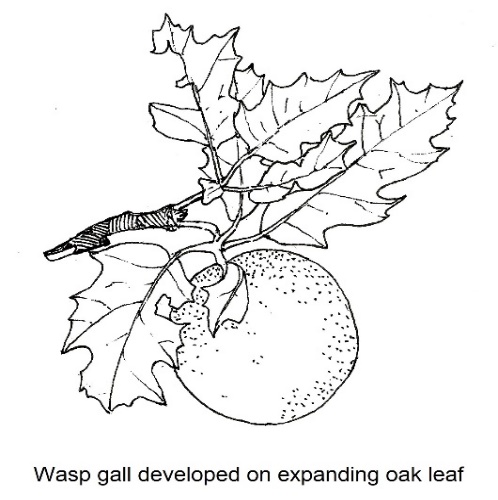You see them in the leaf litter in late summer on hikes in our oak and hickory woodlands. They look like tan golf balls, complete with the stippled surface texture that helps golf balls fly a little farther than they would with a smooth surface. But these balls are light as a feather, with parchment thin skin and an array of cobweb like strings for an inner texture. Ozark hikers often wonder what sort of fruit these are and where they came from. It turns out these are but one of many different varieties of leaf gall created by insects as part of their life cycle.
There are lots of different structures developing out of oak leaves when their growth process is hijacked by insect pests for their own purposes. More than 800 insect species create galls on oak twigs, and over 700 of them are wasps.

These particular galls are so perfectly symmetrical that many observers figure they must be some kind of exotic fruit and not just a deformed oak leaf. Some leaf galls are not nearly as noticeable as the papery balls described here. In the case of the round “golf ball” structures in question we have part of the life cycle of a gall wasp.
There are two related gall wasp species that produce such round structures on oak leaves and they are commonly known as oak-apple gall wasps. The name is derived from one of these that produces a gall interior that looks like the flesh of a freshly sliced apple.

The galls we most often see have a light interior web of fibers and are the work of the wasp Amphibolips quercusinanis.
If you look carefully, you can see the green galls embedded in the expanding new growth of oak twigs in the mid spring when the local woods are finally beginning to green up. The female wasp has injected her egg along with a special mix of chemicals into the bud that will become the new twig when new growth just begins. The exact processes that control this are still not fully understood. The injected chemicals must be some combination of growth hormones that act to deflect the normal growth of a leaf while it is just developing. So, this is a process where the pre-formed meristem tissue that is destined to become the leaf executes the growth programmed into cellular DNA under a set of hijacked instructions.
The complexity of the gall forming process is demonstrated by the fact that the deformed leaf growth does more than just provide a house for the juvenile wasp “worm”. The hijacked growth process as the gall develop its interior “cobwebs” has them connected to a starchy capsule around the growing wasp larva. That substance is food for the young wasp, and the leaf continues to produce a generous supply of wasp food until the larva matures and escapes.
The gall illustrated in my sketch was collected from the branch of a black oak on the edge of the forest on the grounds of Crystal Bridges Museum of American Art on April 26, 2020.

You can see how the gall grows out of the tissue of the deformed oak leaf. You see the intact gall growing out of the terminal leaf in a twig where the other leaves have expanded to less than half their full size. This illustrates how critical it is for gall development to act on the “stem cell” (no pun intended) nature of the developing leaf tissue. My illustration also shows the sectioned gall with a better indication of how the gall structure is attached to the developing oak leaf, along with the fibrous network around the edible capsule sheltering the wasp larva. The mature wasp is a small, nearly black creature most notable for a disproportionately long pair of antennae. All of this yet another demonstration of the wonderous and intricate complexity of the natural world around us.
